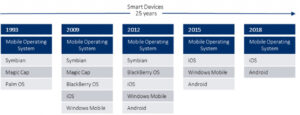Commercial mobile OS – 25 year battle
Mobile operating systems started life on mobile phones and personal digital assistants (palm pilot). Over the next 25 years mobile phones and pda’s would arguably merge together and form what we call today the “smart phone”, during this time tablets and notes made their debut into the mobile market running nearly the same mobile operating system. Looking at mobile operating systems that run on both mobile phones and tablets only two players seemed to have survived the 25 year battle, Android (Google) and iOS (Apple).
Microsoft has successfully refocused their business approach after their mistimed run in the mobile phone market by running Windows 10, a computer operating system on tablets, immediately asking the question of whether a dedicated Mobile OS is really necessary. In other words, Windows technically don’t have a mobile operating system and appear to be transforming Windows 10 to resemble a mobile operating system through the use of apps and apps stores. It should also be mentioned that Microsoft has strength in its office suite (Word, Excel, etc) which is available on Android and Apple apps stores.
Small chip vs. big chip
When comparing mobile operating systems and computer operating systems from the same developer, for example, Android-Chrome and iOS-MacOS, it becomes quite obvious both the operating systems user interfaces are becoming extremely similar, to some extent identical. What’s further highlighted when comparing, is that popular apps are available across both mobile and computer platforms. So why don’t these vendors just have one operating system? The most plausible answer appears to be due to CPU architectures. In context to this article, there are two main types of CPU, mobile platform CPU (small chips) and computer platform CPU (big chips). Examples of popular small and big chips are Snapdragon, Kirin, Intel, and AMD.
Mobile platform CPU’s are power sensitive as their primary function was to run off battery powered devices like mobile phones and pda’s, in turn mobile operating systems are optimised to be continuously power conscious, ultimately working toward all day mobile device use. Computer platform CPU’s on the other hand, did not have power restrictions as power was available straight from the wall socket or being powered by large lithium batteries (e.g. laptop batteries), allowing computer operating systems more freedom in development.
Over the last 10 years, a steady decline in computer sales has been observed whilst mobile device sales have continued to rise. The effect of this market trend is two-fold:
- More mobile CPU’s are being sold vs computer CPU’s
- More mobile operating systems are being interfaced with vs computer operating systems.
This trend could likely explain why the Android-Chrome and iOS-MacOS interfaces a becoming more similar as the years go on, perhaps to allow consumers to easily transition into a more converged environment in the future?
Another trend occurring simultaneously is based on Moore’s law. Mobile platform CPU’s are now powerful enough to be used on laptops, blurring the once clear distinction between what devices small and big chips are supposed to run on. Begging the question, if mobile CPU architectures can be transitioned across both mobile and computer platforms do we need two different strands of operating systems?
State of flux
With the information at hand, three possible outcomes appear most likely.
- Mobile OS’s like Android and iOS becomes the new normal and used across computer platforms.
- In the case of Microsoft, the computer operating system are portable enough to be used on mobile devices and computers
- Mobile and computer OS’s converge to become something new, to run across both mobile devices and computers
Movement has been seen on all three possible outcomes. Samsung appears to be replacing the need for a laptop altogether by using a mobile phone and Android OS as a desktop. Microsoft has the Surface pro, a tablet with a computer operating system (Windows 10). Google (Android-Chrome) and Apple (iOS-MacOS) are blurring the boundaries between the look and feel of both their operating systems perhaps chasing convergence.
Operating systems- Picture the future
Question – what will the industrial Enterprise Operations Centre for the future look like? A question we are asking ourselves now to ensure we remain relevant to our customers tomorrow.







